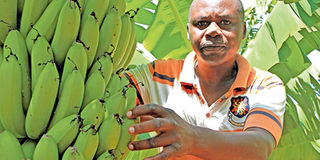Teachers’ boss with 600 banana plants side hustle

Dr Patrick Mutua in his farm in Makueni County where he has grown 600 tissue culture bananas of the Williams variety. Tissue culture seedlings are propagated in the laboratory through cloning and then hardened in a greenhouse before they are transplanted to the fields. PHOTO | PIUS MAUNDU | NATION MEDIA GROUP
What you need to know:
- The three-acre farm belongs to Dr Patrick Mutua and he has grown 600 tissue culture bananas of the Williams variety.
- Bananas are the most popular fruits in the country followed by mangoes. They are a main source of carbohydrates for some communities who cook the green types.
- In Ukambani, the fruits that contain vitamin B6, vitamin C and potassium are mainly eaten ripe, and are used to make pudding.
- Inorganic fertiliser, he says, can be added during planting alongside manure and after every few months at 100g per plant.
Tens of banana plants sag under the weight of their heavy fruits on a farm in Makaani village, off the newly tarmacked Kibwezi-Kitui road in Makueni county. The plants are eye-catching, considering that this is a dry area.
The three-acre farm belongs to Dr Patrick Mutua and he has grown 600 tissue culture bananas of the Williams variety.
“This is my side hustle,” the immunologist tells Seeds of Gold as he adjusts a wooden pole supporting a huge bunch of banana fruits. “The bunches weigh up to 70kg upon maturity and go for between Sh600 and Sh1,000, depending on the size.”
The bananas are grown six metres apart from one row to another, are mulched and farmed under irrigation, with water pumped from the neighbouring River Athi into a tank before it is supplied to the crops.
“The mulch prevents weeds and ensures that little water is lost through evaporation,” explains Dr Mutua, who works as the Teachers Service Commission director in-charge Ganze sub-county in Kilifi County.
He was inspired to start growing bananas by a friend.
“A neighbour’s small banana farm made me get into the business. They were doing so well and I asked him to offer me some lessons,” he recalls.
Bananas are the most popular fruits in the country followed by mangoes. They are a main source of carbohydrates for some communities who cook the green types. They are also used for making pastries and wines when processed.
In Ukambani, the fruits that contain vitamin B6, vitamin C and potassium are mainly eaten ripe, and are used to make pudding.
“I sell my produce when they mature in eight to 12 months to traders in Kibwezi, Ikutha and Mutomo townships,” says Dr Mutua, one of the largest suppliers of the fruits in the area. Other fruits are imported from Kisii, Meru and Taita-Taveta counties.
BETTER ADAPTED
To plant the tissue culture seedlings, which he sources from Jomo Kenyatta University of Agriculture and Technology, he digs pits measuring three feet squared, that is, in length and width, and the depth is the same size.
“The first 1.5 feet top soil is scooped and isolated and mixed with two 10kg buckets of manure. This mixture is then filled into the pits and the seedlings planted. The top third of the pit should be left uncovered to create a basin for water collection to support the plant in the initial stages,” he says, adding that watering is then done once a week.

Dr Mutua in his banana farm. Inspired by the growing demand for tissue culture bananas, he is working on installing a laboratory for propagating seedlings to expand his business. PHOTO | PIUS MAUNDU | NATION MEDIA GROUP
Inorganic fertiliser, he says, can be added during planting alongside manure and after every few months at 100g per plant.
To keep monkeys and intruders at bay, Dr Mutua, who invested Sh450,000 in capital in the business, has installed an electric fence around the orchard. He has one permanent employee and hires several others when the need arises.
To reap from bananas, one should embrace quality planting materials and good management practices.
“Preferably, plant the tissue culture varieties which are free of diseases and yield in plenty. Also, ensure that the orchard is free of weeds and manage the suckers through pruning ensuring each parent plant remains with two or three,” he says.
Tissue culture seedlings are propagated in the laboratory through cloning and then hardened in a greenhouse before they are transplanted to the fields.
The resulting seedlings are better adapted to fight pests and diseases such as banana streak and bacterial wilt.
“Although smallholder farmers still use suckers to propagate bananas, we discourage them because they transfer pests and diseases from one farm to the other, and produce relatively lower yields,” says Prof Aggrey Bernard Nyende, the director of the Institute of Biotechnology Research at Jomo Kenyatta University of Agriculture and Technology.
Inspired by the growing demand for tissue culture bananas, Dr Mutua, who visits his farm every weekend, is working on installing a laboratory for propagating seedlings to expand his business.
****
Get it fast
Managing your banana field
- Besides pruning and propping, each plant should have no more than two or three suckers
- Watch out for nematodes and have an agronomist visit the farm at least once every three months to assess the progress.
- Although tissue culture bananas are not prone to attacks by pests, the application of a pesticide at the planting stage as advised by agronomists affords farmers the needed peace of mind.
- Bananas mature in eight to 12 months from the date of planting.
- Scout for snails and others pests.





